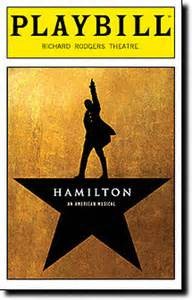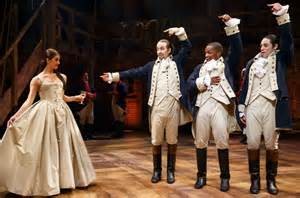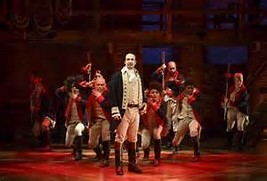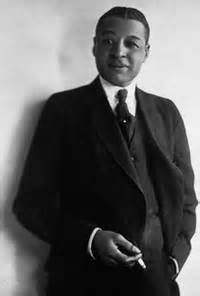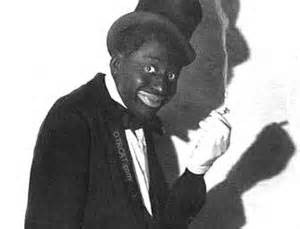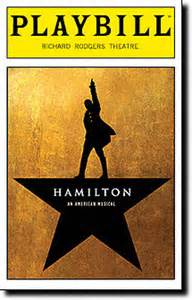
The new Lin-Manuel Miranda (In the Heights) musical Hamilton has garnered a lot of attention and praise. It almost immediately sold out its Off-Broadway run at the Public Theatre, was designated for transfer to Broadway just after it opened to five-star reviews, and now that it’s in previews on Broadway every celeb wants to be seen at what is considered to be a groundbreaking show.
Getting the obvious out of the way, this is a piece of musical theatre that is expertly crafted, directed, and performed. Miranda is a genius, and with director Thomas Kail, choreographer Andy Blankenbuehler, and musical director Alex Lacamoire, he’s created a theatrical piece that works on many different levels.
Past and Future Brought Together?
Some pundits are saying that this musical is about the future of America. This is for a few reasons with one being that most of the leads, in stark contrast to our white founding fathers, are being played by men of color. In other words, this is a colorblind production and making it thus reveals the future of what our country can be.
However, more so and more importantly, the casting, which features superlative performances, is not just about what our country might be one day, but what it is now. This musical is a living paradigm of society today, where color lines in the eyes of many of those who are just being born and those who are in their late-twenties to early-thirties mean little to nothing when it comes to working together, falling in love, or creating lasting friendships.
Race, Violence, and Injustice
Of course our country is in no way perfect, much like any performance of a live theatrical event where mistakes are made, performances morph and shift, and each audience brings its own energy. We are not all colorblind in the U.S., but we are living in a time when less than a decade ago most of us could not have imagined the President of the United States being black, police officers and departments across the country having to answer for their unconstitutional and illegal practices, and South Carolina permanently and officially removing the Confederate flag from its state house.
The musical Hamilton is a complex mix of history, character, and motivations set to a nonstop contemporary music score, accented by hip hop and R&B rhythms, and told through lyrics that are brimming with insight, cleverness, and irony. In its Gestalt it is the epitome of not the America of the future but of the America of today.
There’s a great historical irony to having so many people of color play white Americans. The obvious one has to do with the fact that some of those on stage may be playing those who may have actually enslaved their forebears.
The other, less-obvious irony has to do with the fact that white stage actors first defined black characters in the U.S. From the time that Thomas D. Rice first did his Jump Jim Crow act to minstrelsy to the hundreds of Uncle Tom productions that played in the U.S. for more than 60 years to Al Jolson through to so many more performers and productions, blacks were told how to speak, act, and talk by whites.
This white definition of what it was to be black was so pervasive that for decades black performers would use pitch-black makeup to darken their skin and white to exaggerate their lips and the palms of their hands so they would fit the image that white actors had created. They spoke in the black dialect whites spoke on stage and mimicked the shuffling body movements of their white interpreters. With Hamilton all of that is reversed.
What makes Hamilton so powerful is it is a work of art that in many ways reveals what may be the final pitched battle between those who feel the need, for whatever reason, to create divisions by race, and those who see race as a social construct that has been foisted upon them by long-dead theorists, social scientists, and political leaders.
Naive to Say
Of course, to say that the U.S. is colorblind, or that racial tensions and divides don’t exist, or that there are not still major injustices in what should be a system of equal justice would be not only naïve, but wrong, to say. The facts are our prison system is filled with a disproportionate percentage of men and women of color, men and women of color are still marginalized in many ways, and the low standard of living combined with high crime rates and levels of drug use in minority communities are beyond alarming.
At the same time, there are many people trying to make a difference in a variety of ways. These earnest folks are living in a time when change is eminently possible, however, it is still difficult to engender.
Imperfect World
There will never be a perfect world as far as race and how it defines us is concerned. But what Hamilton and its popularity says, what this piece of art emulates, is that because we are now willing to begin to address day-to-day racial injustices in this country and think of humankind as an entity of equals and not as disparate colors, that in the here and now while we watch this musical in the theatre we are not seeing the future but experiencing the present.
In an imperfect world, it is comforting and inspiring to know that such an experience exists. Hopefully, Hamilton will help us take the next steps necessary towards creating a country where the definition of race has become obsolete. In doing so, we should remember all that was unimaginable less than a decade ago that is now reality, and boldly address the challenges that lie before us. The musical Hamilton is past, present, and future in one.

